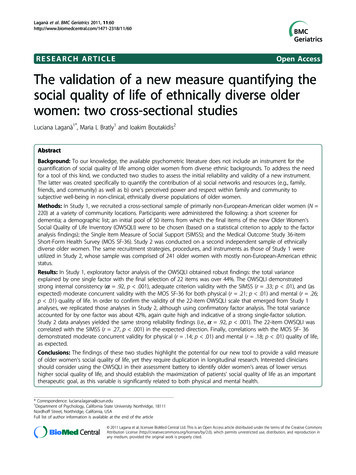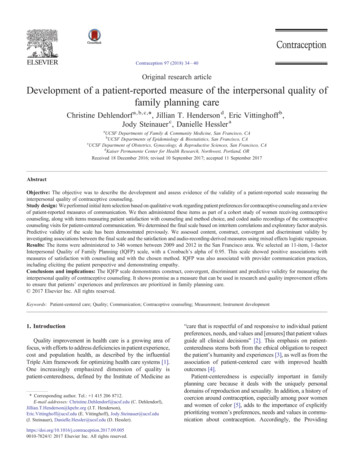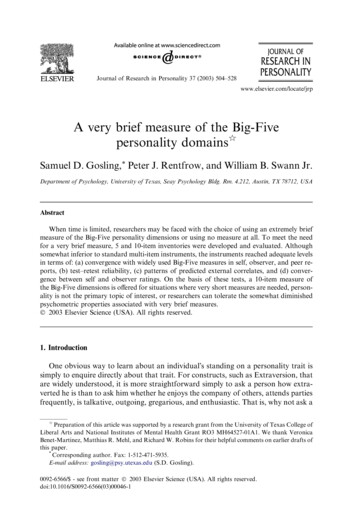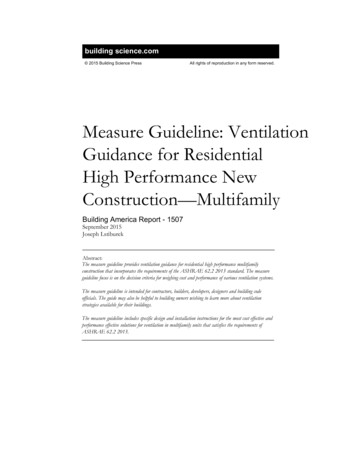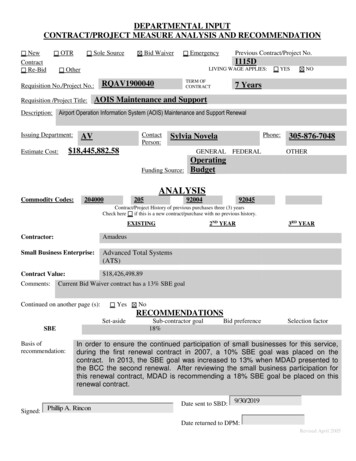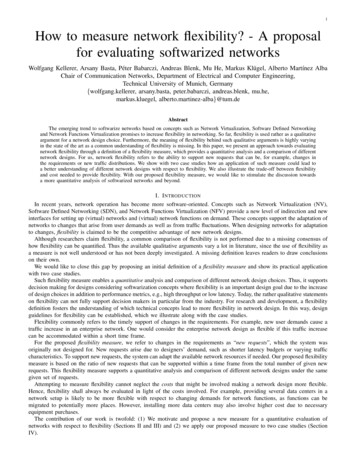
Transcription
1How to measure network flexibility? - A proposalfor evaluating softwarized networksWolfgang Kellerer, Arsany Basta, Péter Babarczi, Andreas Blenk, Mu He, Markus Klügel, Alberto Martı́nez AlbaChair of Communication Networks, Department of Electrical and Computer Engineering,Technical University of Munich, Germany{wolfgang.kellerer, arsany.basta, peter.babarczi, andreas.blenk, mu.he,markus.kluegel, alberto.martinez-alba}@tum.deAbstractThe emerging trend to softwarize networks based on concepts such as Network Virtualization, Software Defined Networkingand Network Functions Virtualization promises to increase flexibility in networking. So far, flexibility is used rather as a qualitativeargument for a network design choice. Furthermore, the meaning of flexibility behind such qualitative arguments is highly varyingin the state of the art as a common understanding of flexibility is missing. In this paper, we present an approach towards evaluatingnetwork flexibility through a definition of a flexibility measure, which provides a quantitative analysis and a comparison of differentnetwork designs. For us, network flexibility refers to the ability to support new requests that can be, for example, changes inthe requirements or new traffic distributions. We show with two case studies how an application of such measure could lead toa better understanding of different network designs with respect to flexibility. We also illustrate the trade-off between flexibilityand cost needed to provide flexibility. With our proposed flexibility measure, we would like to stimulate the discussion towardsa more quantitative analysis of softwarized networks and beyond.I. I NTRODUCTIONIn recent years, network operation has become more software-oriented. Concepts such as Network Virtualization (NV),Software Defined Networking (SDN), and Network Functions Virtualization (NFV) provide a new level of indirection and newinterfaces for setting up (virtual) networks and (virtual) network functions on demand. These concepts support the adaptation ofnetworks to changes that arise from user demands as well as from traffic fluctuations. When designing networks for adaptationto changes, flexibility is claimed to be the competitive advantage of new network designs.Although researchers claim flexibility, a common comparison of flexibility is not performed due to a missing consensus ofhow flexibility can be quantified. Thus the available qualitative arguments vary a lot in literature, since the use of flexibility asa measure is not well understood or has not been deeply investigated. A missing definition leaves readers to draw conclusionson their own.We would like to close this gap by proposing an initial definition of a flexibility measure and show its practical applicationwith two case studies.Such flexibility measure enables a quantitative analysis and comparison of different network design choices. Thus, it supportsdecision making for designs considering softwarization concepts where flexibility is an important design goal due to the increaseof design choices in addition to performance metrics, e.g., high throughput or low latency. Today, the rather qualitative statementson flexibility can not fully support decision makers in particular from the industry. For research and development, a flexibilitydefinition fosters the understanding of which technical concepts lead to more flexibility in network design. In this way, designguidelines for flexibility can be established, which we illustrate along with the case studies.Flexibility commonly refers to the timely support of changes in the requirements. For example, new user demands cause atraffic increase in an enterprise network. One would consider the enterprise network design as flexible if this traffic increasecan be accommodated within a short time frame.For the proposed flexibility measure, we refer to changes in the requirements as “new requests”, which the system wasoriginally not designed for. New requests arise due to designers’ demand, such as shorter latency budgets or varying trafficcharacteristics. To support new requests, the system can adapt the available network resources if needed. Our proposed flexibilitymeasure is based on the ratio of new requests that can be supported within a time frame from the total number of given newrequests. This flexibility measure supports a quantitative analysis and comparison of different network designs under the samegiven set of requests.Attempting to measure flexibility cannot neglect the costs that might be involved making a network design more flexible.Hence, flexibility shall always be evaluated in light of the costs involved. For example, providing several data centers in anetwork setup is likely to be more flexible with respect to changing demands for network functions, as functions can bemigrated to potentially more places. However, installing more data centers may also involve higher cost due to necessaryequipment purchases.The contribution of our work is twofold: (1) We motivate and propose a new measure for a quantitative evaluation ofnetworks with respect to flexibility (Sections II and III) and (2) we apply our proposed measure to two case studies (SectionIV).
2II. F LEXIBILITY OF S OFTWARIZED N ETWORKS IN L ITERATUREIn this section, we extract examples for the definition of flexibility applied on SDN, NFV and NV and, if described, showhow flexibility is expressed within each context and its relation to cost.SDN has been developed to target programmable flows and to centralize network control, which contributes to flexibility interms of flow steering and configuration. We can assess such flexibility needs in terms of potential vs. actually possible flowconfigurations. In fact, OpenFlow (OF) [1], the most commonly used protocol to implement SDN, has an upper bound on itsflexibility due to the limited set of configurations specified in each protocol version. For instance, flow configuration based onapplication layer information, e.g., HTTP requests, from flow packets are not yet available with the latest OF protocol version1.5 [2]. Another notion of flexibility in SDN is control plane distribution. The framework “Kandoo” [3] for example looks intopreserving scalability for SDN networks in data centers. It has two layers of controllers, a lower layer with no knowledge ofthe network-wide state and an upper layer with a logically centralized controller maintaining network-wide state. Evaluationsshow that bandwidth and control load savings start from a fanout of four, i.e., one core switch and four top-of-rack switches.Hence, savings promised by the provided flexibility vary across design choices.With NFV, network functions get developed as software and are executed on commodity hardware. This offers flexibilityto define and program network functions more easily [4]. NFV can also provide flexibility in terms of resource scaling, e.g.,scale up resources assigned to a network function or scale out a function on multiple hardware entities. Software functions alsocontribute to the flexibility in the function placement. However, similar to SDN, flexibility of NFV is not absolute and mighthave a cost impact on performance. [5] shows a trade-off between flexibility and cost of NFV. It investigates virtualization ofnetwork middleboxes as software functions running in a cloud. Middleboxes contribute to a large fraction of network domains,thus software inter-changeable middleboxes can promise a huge increase in flexibility. The evaluation shows that flexibility ofsoftware middleboxes can induce cost in terms of increased latency depending on the cloud provider and solution taken, up toan additional 52% in the worst case.NV abstracts network resources from physical infrastructure with the scope of adding flexibility to network resourcesprovisioning. With existing networking hardware, virtualization provides the ability to add or adapt virtual networks whenneeded, which is argued to provide the needed flexibility to the ossified Internet architecture [6]. Addressing migration, forinstance, to evaluate the flexibility of virtual networks, [7] shows a study for live migration of virtual switches. Live migrationprovides flexibility in adapting the virtual network topology. The evaluation shows that the introduced solution can successfullyachieve migration without packet loss, i.e., transparent to the service. However, an extra software layer is added that comes ata control overhead of up to 7%. This means that gains in terms of topology flexibility offered by NV might have drawbackson the network performance.Overall, we can observe that flexibility is highly present in literature and, in particular, used as an argument in softwarizednetworks. However, a common measure for a quantitative analysis of flexibility is missing. Such analysis should be part of acomprehensive analysis of the network design space to show why a design choice is flexible and to what extent.III. F LEXIBILITY AS A N EW M EASUREIn our proposed flexibility analysis, we compare the flexibility of different network design choices of a system. Hence,flexibility analysis is always specific to the particular system under comparison. A system in this context is based on anarchitecture and a network topology. It implements network algorithms and protocols and it comes with certain resourcecharacteristics such as link capacities and processing capabilities. Running a system comes at a certain cost to which we referin Section III-C. To analyze network flexibility, we challenge the system with ”new requests”, i.e., request new requirementsor input new traffic distributions and see if they can be supported.A. Proposal for a Flexibility MeasureWe define the flexibility ϕ of a system S, dependent on its current state, as the fraction of new requests that can be supportedfrom a given set and sequence of new requests, within a given time threshold T . This notion is formalized in Eq.1. As thenumber of supported requests is always smaller or equal to the number of total requests, the flexibility is always in the interval[0, 1] and can be expressed as a percentage.ϕT (S) supported new requests within time threshold T total given new requests (1)When the time threshold T becomes infinite, we arrive at a simplified flexibility measure ϕ (S), which is independent oftime. This helps us to assess the ability of a system to support requests in principle. See [8] for an example.Fig. 1 illustrates a simple example. It shows an SDN network with one controller (CTR). In SDN, the controller is anetwork function that is deployed on a physical node. The initial controller capacity (cc), i.e., CPU resources required to runthe controller, equals to 1. An increase of the control traffic generates a new request to increase the controller capacity to 2(upper left side figure). This request requires the controller to migrate to a node that has a node capacity (nc), i.e., available
3max. migration time T 1 hopmax. migration time T 1 hopnew cc 3nc 1new cc 2nc 1nc 3nc 1nc 3nc 1nc 1new cc 4CTRCTRCTRCTRmax. migration time T 1 hopCTRnc 3nc 1CTRnew request can be supportedmax. migration time T new request can not be supportedmax. migration time T new cc 3nc 1new cc 2 nc 3 nc 1new cc 4CTRnc 3nc 1new request can not be supportedmax. migration time T nc 1CTRCTRnc 1nc 2nc 2nc 2CTRnc 3nc 1CTRnc 2new request can be supportednc 2nc 2new request can be supportednew request can not be supportedFig. 1: Flexibility measure example; requests support within a given time threshold T. (CTR): SDN controller. (cc): controllerrequired capacity, (nc): node available capacity.CPU resources, of 2. In the following, we assume that a migration over a 1 hop link takes 1 time unit. When a maximummigration time threshold T of 1 unit is allowed, the controller would be able to migrate and hence, this network is flexibleenough to support the request. In case the new controller capacity request is 3 and the maximum migration time T threshold is1, the network would fail to support this request, which is shown in the upper middle figure. Even though the network containsa node with a capacity of 3, the system is not flexible enough to support the controller migration within 1 time unit. In casethe migration time T is not a constraint, i.e., goes to (lower middle figure), this network design would be able to supportthe new controller capacity request of 3. Note that if the request for the controller capacity 4 (both right side figures), thisnetwork would not be able to support it regardless of the time T . Hence, with this given set of new requests for controllercapacity (r1 , r2 , r3 ) (2, 3, 4), the flexibility of this network under a migration time T of 1 unit is ϕ1 (S) 1/3 0.33(upper figures) and without a requirement on the migration time would be ϕ (S) 2/3 0.66 (lower figures). For a simpleillustration, in this example, we consider only a small number of requests that have equal probability of their occurrence. Inreality, the set of given requests and their probability distribution may be larger and more complex.TABLE I: Technical concepts and their support of flexibility in networks. ( : main target).Category (see Sec. III-B)Adapt ConfigurationLocate FunctionsScaleAspect (see Sec. III-B)Flow Config.: flow steeringFunction Config.: function programmingParameter Config.: change function parametersFunction Placement: distribution, placement, chainingResource and Function Scaling: processing and storage capacity, number of functionsTopology Adaptation: (virtual) network adaptationSDN NFV NV B. Flexibility AspectsFlexibility as a measure is used with a specific objective in mind. To reflect such objectives, we come up with flexibilityaspects derived from the technologies SDN, NFV and NV (Sec. II). A flexibility aspect describes a concrete ability in whicha network can adapt, e.g., ch
The emerging trend to softwarize networks based on concepts such as Network Virtualization, Software Defined Networking and Network Functions Virtualization promises to increase flexibility in networking. So far, flexibility is used rather as a qualitative argument for a network design choice. Furthermore, the meaning of flexibility behind .
